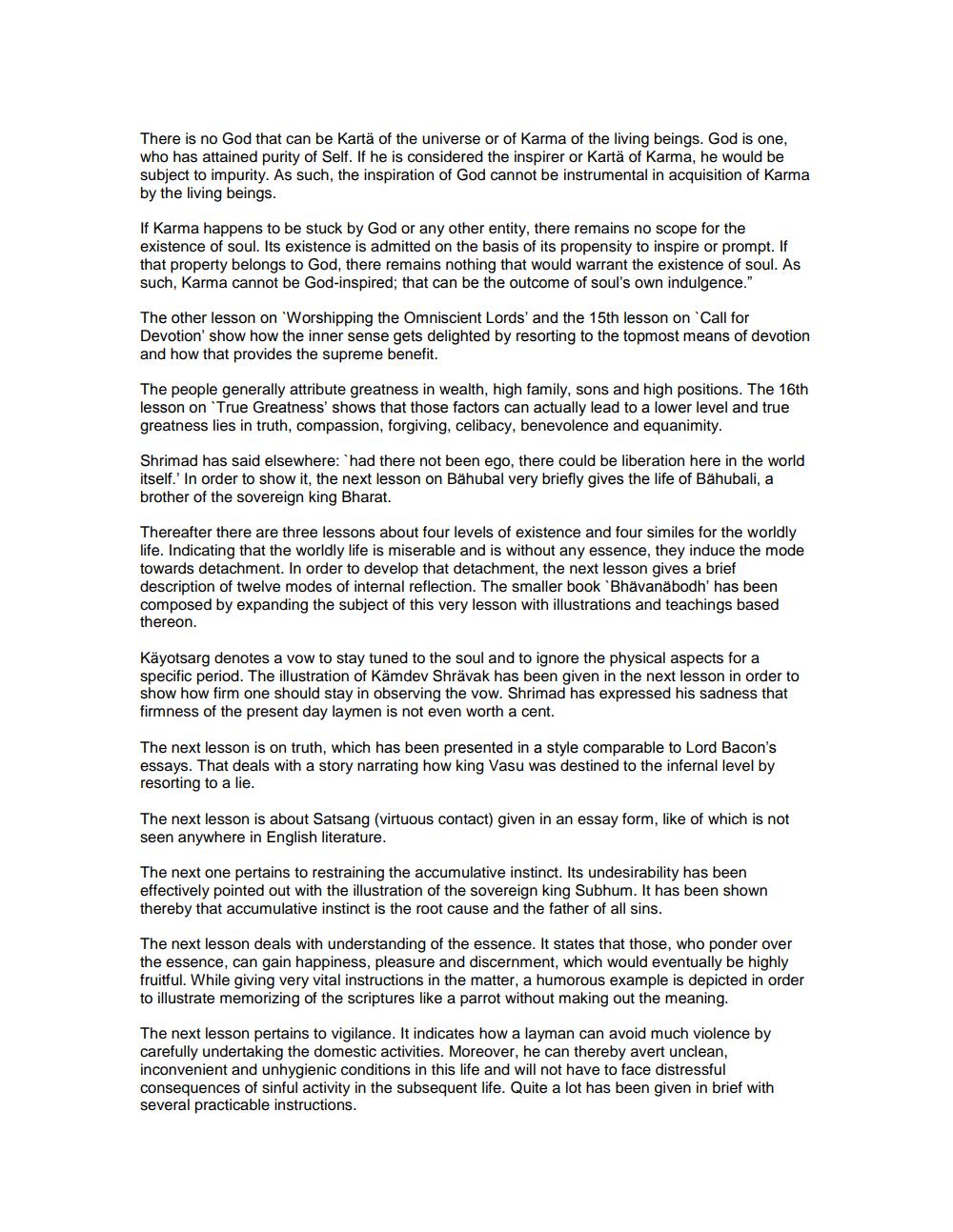________________
There is no God that can be Karta of the universe or of Karma of the living beings. God is one, who has attained purity of Self. If he is considered the inspirer or Karta of Karma, he would be subject to impurity. As such, the inspiration of God cannot be instrumental in acquisition of Karma by the living beings.
If Karma happens to be stuck by God or any other entity, there remains no scope for the existence of soul. Its existence is admitted on the basis of its propensity to inspire or prompt. If that property belongs to God, there remains nothing that would warrant the existence of soul. As such, Karma cannot be God-inspired; that can be the outcome of soul's own indulgence."
The other lesson on 'Worshipping the Omniscient Lords' and the 15th lesson on 'Call for Devotion' show how the inner sense gets delighted by resorting to the topmost means of devotion and how that provides the supreme benefit.
The people generally attribute greatness in wealth, high family, sons and high positions. The 16th lesson on True Greatness' shows that those factors can actually lead to a lower level and true greatness lies in truth, compassion, forgiving, celibacy, benevolence and equanimity.
Shrimad has said elsewhere: 'had there not been ego, there could be liberation here in the world itself.' In order to show it, the next lesson on Bähubal very briefly gives the life of Bahubali, a brother of the sovereign king Bharat.
Thereafter there are three lessons about four levels of existence and four similes for the worldly life. Indicating that the worldly life is miserable and is without any essence, they induce the mode towards detachment. In order to develop that detachment, the next lesson gives a brief description of twelve modes of internal reflection. The smaller book 'Bhävanäbodh' has been composed by expanding the subject of this very lesson with illustrations and teachings based thereon.
Käyotsarg denotes a vow to stay tuned to the soul and to ignore the physical aspects for a specific period. The illustration of Kämdev Shrävak has been given in the next lesson in order to show how firm one should stay in observing the vow. Shrimad has expressed his sadness that firmness of the present day laymen is not even worth a cent.
The next lesson is on truth, which has been presented in a style comparable to Lord Bacon's essays. That deals with a story narrating how king Vasu was destined to the infernal level by resorting to a lie.
The next lesson is about Satsang (virtuous contact) given in an essay form, like of which is not seen anywhere in English literature.
The next one pertains to restraining the accumulative instinct. Its undesirability has been effectively pointed out with the illustration of the sovereign king Subhum. It has been shown thereby that accumulative instinct is the root cause and the father of all sins.
The next lesson deals with understanding of the essence. It states that those, who ponder over the essence, can gain happiness, pleasure and discernment, which would eventually be highly fruitful. While giving very vital instructions in the matter, a humorous example is depicted in order to illustrate memorizing of the scriptures like a parrot without making out the meaning.
The next lesson pertains to vigilance. It indicates how a layman can avoid much violence by carefully undertaking the domestic activities. Moreover, he can thereby avert unclean, inconvenient and unhygienic conditions in this life and will not have to face distressful consequences of sinful activity in the subsequent life. Quite a lot has been given in brief with several practicable instructions.




